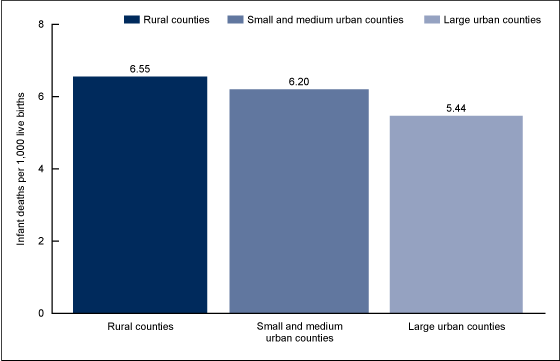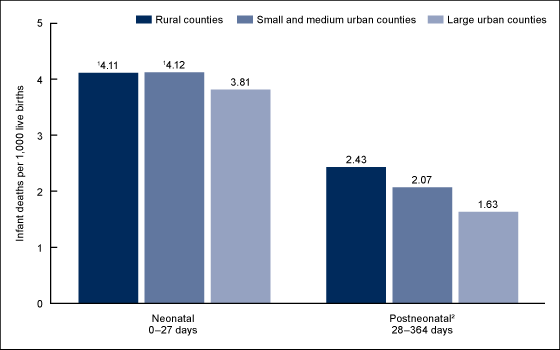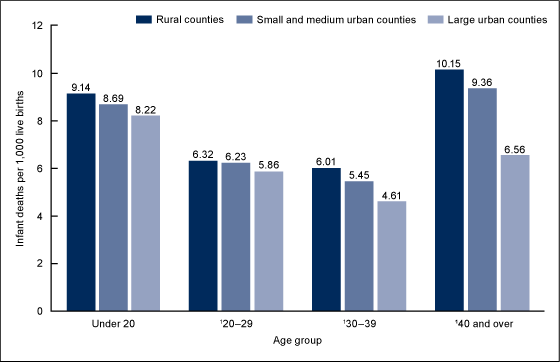Infant Mortality Rates in Rural and Urban Areas in the United States, 2014
On This Page
- Key findings
- Overall, infant mortality rates were highest in rural areas and lowest in large urban areas.
- Neonatal and postneonatal mortality rates were higher in rural counties than in large urban counties in 2014.
- Mortality rates were highest in rural counties for infants of mothers in most age groups in 2014.
- Mortality rates were lowest in large urban counties for infants of non-Hispanic white and non-Hispanic black mothers in 2014.
- Summary
- Definitions
- Data sources and methods
- About the authors
- References
- Suggested citation
NCHS Data Brief No. 285, September 2017
PDF Version (733 KB)
Danielle M. Ely, Ph.D., Anne K. Driscoll, Ph.D., and T.J. Mathews, M.S.
Key findings
Data from the National Vital Statistics System
- Infant mortality rates decreased as urbanization level increased, from 6.55 deaths per 1,000 births in rural counties to 6.20 in small and medium urban counties and 5.44 in large urban counties.
- Neonatal mortality rates were higher in rural counties than in large urban counties, and postneonatal mortality rates decreased as urbanization level increased.
- Mortality rates decreased as urbanization level increased for infants of mothers aged 20–29, 30–39, and 40 and over.
- For infants of non-Hispanic white and non-Hispanic black mothers, mortality rates were lowest in large urban counties.
The infant mortality rate is often used as a measure of a country’s health because similar factors influence population health and infant mortality (1). Although infant mortality has declined in the United States, disparities still exist across geographic areas and demographic groups (2–4). Urbanization level, based on the number and concentration of people in a county, can impact health outcomes (3–9). Previous research indicates that infant mortality rates vary by urbanization level and also by maternal and infant characteristics (3–9). This report describes differences in infant mortality among rural, small and medium urban, and large urban counties in the United States by infant’s age at death, mother’s age, and race and Hispanic origin in 2014.
Keywords: maternal age, race and Hispanic origin, National Vital Statistics System
Overall, infant mortality rates were highest in rural areas and lowest in large urban areas.
- In 2014, the infant mortality rate decreased as urbanization level increased. Infant mortality in rural counties was 6.55 deaths per 1,000 births, 6% higher than in small and medium urban counties (6.20) and 20% higher than in large urban counties (5.44) (Figure 1).
- The infant mortality rate for small and medium urban counties was 14% higher than the rate in large urban counties.
Figure 1. Infant mortality rates, by urbanization level: United States, 2014
NOTES: Significant decreasing linear trend from rural counties to large urban counties (p < 0.05). County designation is based on mother’s county of residence. County classification is based on 2013 NCHS Urban–Rural Classification Scheme for Counties. Access data table for Figure 1.
SOURCE: NCHS, National Vital Statistics System.
Neonatal and postneonatal mortality rates were higher in rural counties than in large urban counties in 2014.
- Neonatal mortality was 8% higher in both rural (4.11 per 1,000 births) and small and medium urban (4.12) counties compared with large urban counties (3.81) (Figure 2).
- Postneonatal mortality decreased as urbanization level increased and was 17% higher in rural counties (2.43) than in small and medium urban counties (2.07) and 49% higher than in large urban counties (1.63).
Figure 2. Infant mortality rates, by urbanization level and infant age at death: United States, 2014
1Significantly different from large urban counties (p < 0.05).
2Significant decreasing linear trend from rural counties to large urban counties (p < 0.05).
NOTES: County designation is based on mother’s county of residence. County classification is based on 2013 NCHS Urban–Rural Classification Scheme for Counties. Access data table for Figure 2.
SOURCE: NCHS, National Vital Statistics System.
Mortality rates were highest in rural counties for infants of mothers in most age groups in 2014.
- For infants of mothers aged 20–29, 30–39, and 40 and over, mortality rates decreased as urbanization level increased (Figure 3).
- Compared with large urban counties, the infant mortality rate in rural areas was 8% higher for infants of mothers aged 20–29 (6.32 per 1,000 births compared with 5.86), 30% higher for infants of mothers aged 30–39 (6.01 and 4.61, respectively), and 54% higher for infants of mothers aged 40 and over (10.15 and 6.56, respectively).
- For infants of mothers under age 20, the pattern was consistent with older age groups, but the decreasing trend in rates across urbanization levels was not statistically significant.
Figure 3. Infant mortality rates, by urbanization level and age of mother: United States, 2014
1Significant decreasing linear trend from rural counties to large urban counties (p < 0.05).
NOTES: County designation is based on mother’s county of residence. County classification is based on 2013 NCHS Urban–Rural Classification Scheme for Counties. Access data table for Figure 3.
SOURCE: NCHS, National Vital Statistics System.
Mortality rates were lowest in large urban counties for infants of non-Hispanic white and non-Hispanic black mothers in 2014.
- For infants of non-Hispanic white mothers, the mortality rate decreased as urbanization level increased; mortality for infants of non-Hispanic white mothers in rural counties (5.95 per 1,000) was 41% higher than in large urban counties (4.21) and 13% higher than in small and medium urban counties (5.28) (Figure 4).
- For infants of non-Hispanic black mothers, mortality was 16% higher in rural counties (12.08) and 15% higher in small and medium urban counties (11.90) compared with large urban counties (10.39).
- For infants of Hispanic mothers, the mortality rate was higher in small and medium urban counties (5.32) compared with large urban counties (4.84). While the rate for rural counties (5.32) was similar to the rate for small and medium urban counties, the difference compared with large urban counties was not statistically significant.
Figure 4. Infant mortality rates, by urbanization level and race and Hispanic origin of mother: United States, 2014
1Significantly different from large urban counties (p < 0.05).
2Significant decreasing linear trend from rural counties to large urban counties (p < 0.05).
NOTES: County designation is based on mother’s county of residence. County classification is based on the 2013 NCHS Urban–Rural Classification Scheme for Counties. Access data table for Figure 4.
SOURCE: NCHS, National Vital Statistics System.
Summary
Infant mortality rates varied by urbanization level overall and for key maternal and infant characteristics. For most maternal and infant characteristics, infant mortality rates were higher in rural counties than in large urban counties. These findings add to previous research on infant mortality by using expanded urban categorizations rather than a single urban classification in a rural-urban dichotomy, linked birth and infant death certificate data, and more recent data (3–9).
The findings in this report are consistent with previous research and present new data indicating that small and medium urban county infant mortality rates generally fall between the rates of rural and large urban counties (3,4,6). These findings suggest a general disadvantage in infant survival for rural counties and among certain groups compared with more urbanized areas.
Definitions
Infant mortality rate: Number of infant (aged under 1 year) deaths per 1,000 live births.
Neonatal and postneonatal infant deaths: Neonatal infant deaths occur within the first 28 days from birth. Postneonatal infant deaths occur after 28 days from birth to under 1 year of age.
Race and Hispanic origin: Race and Hispanic origin are reported separately on birth certificates. Persons of Hispanic origin may be of any race. Persons of non-Hispanic ancestry are further classified by race because of differences in fertility and maternal characteristics between Hispanic and non-Hispanic persons. Multiple-race data reported were bridged to single-race categories for comparability between states (10).
Urbanization level: County classification as urban or rural is based on the county of maternal residence (5). Counties were classified according to their metropolitan status using the National Center for Health Statistics (NCHS) Urban–Rural Classification Scheme, by merging the county of maternal residence geographic federal information processing standard (FIPS) codes with county-level FIPS codes from the 2013 NCHS Urban–Rural Classification Scheme data set. Metropolitan counties include large central counties, the fringes of large counties (suburbs), medium counties, and small counties. Nonmetropolitan counties include micropolitan statistical areas and noncore areas, including open countryside, rural towns (populations of less than 2,500), and areas with populations of 2,500–49,999 that are not part of larger labor market areas (metropolitan areas). Due to the variation in urban county sizes, urban counties were put into two levels, large (large central and the fringes of large cities) and small and medium (which includes medium and small cities), for comparative purposes in this report. In this report, rural counties include micropolitan and noncore counties.
Data sources and methods
This report contains data from the period linked birth/infant death data set, which is part of the National Vital Statistics System (11). The period linked birth/infant death data set includes all infant deaths under 1 year of age reported on death certificates and all live births reported from birth certificates (11). The period linked birth/infant death data set is the primary data set for analyzing infant mortality trends and patterns in the United States and is the only source for examining race and Hispanic-origin infant mortality and other factors related to birth (11). Linked birth/infant death data sets are available from: https://www.cdc.gov/nchs/data_access/vitalstatsonline.htm.
The NCHS Urban–Rural Classification Scheme data provide geographic FIPS codes and NCHS Urban–Rural Classification Scheme information for all counties in the United States. The NCHS county classification scheme data are available from: https://www.cdc.gov/nchs/data_access/urban_rural.htm.
References to rates indicate that differences are statistically significant at the 0.05 level (10). References to decreasing linear trends are statistically significant at the 0.05 level and were assessed using the Cochran-Armitage test for trends, a modified chi-squared test.
About the authors
Danielle M. Ely, Anne K. Driscoll, and T.J. Mathews are with the National Center for Health Statistics, Division of Vital Statistics, Reproductive Statistics Branch.
References
- CDC. Reproductive health: Infant mortality. 2016.
- Guyer B, Freedman MA, Strobino DM, Sondik EJ. Annual summary of vital statistics: Trends in the health of Americans during the 20th century. Pediatrics 106(6):1307–17. 2000.
- Lishner DM, Larson EH, Rosenblatt RA, Clark SJ. Chapter 12: Rural maternal and perinatal health. In: Ricketts TC, III, editor. Rural health in the United States. New York, NY: Oxford University Press, Inc. 134–149. 1999.
- Singh GK, Siahpush M. Widening rural-urban disparities in all-cause mortality and mortality from major causes of death in the USA, 1969–2009. J Urban Health 91(2):272–92. 2014.
- Ingram DD, Franco SJ. NCHS urban–rural classification scheme for counties. National Center for Health Statistics. Vital Health Stat 2(154). 2012.
- Rowland Hogue CJ, Vasquez C. Toward a strategic approach for reducing disparities in infant mortality. Am J Public Health 92(4):552–6. 2002.
- Meit M, Knudson A, Gilbert T, Yu ATC, Tanenbaum E, Ormson E, et al. The 2014 update of the rural-urban chartbook. Rural Health Reform Policy Research Center. 2014.
- Eberhardt MS, Pamuk ER. The importance of place of residence: Examining health in rural and nonrural areas. Am J Public Health 94(10) 1682–6. 2004.
- Peck J, Alexander K. Maternal, infant, and child health in rural areas: A literature review. In: Gamm L, Hutchinson L, Dabney B, Dorsey A, editors. Rural healthy people 2010: A companion document to healthy people 2010. 2003.
- Martin JA, Hamilton BE, Osterman MJK, et al. Births: Final data for 2015. National vital statistics reports; vol 66 no 1. Hyattsville, MD: National Center for Health Statistics. 2017.
- Mathews TJ, MacDorman MF, Thoma ME. Infant mortality statistics from the 2013 period linked birth/infant death data set. National vital statistics reports; vol 64 no 9. Hyattsville, MD: National Center for Health Statistics. 2015.
Suggested citation
Ely DM, Driscoll AK, Mathews TJ. Infant mortality rates in rural and urban areas in the United States, 2014. NCHS data brief, no 285. Hyattsville, MD: National Center for Health Statistics. 2017.
Copyright information
All material appearing in this report is in the public domain and may be reproduced or copied without permission; citation as to source, however, is appreciated.
National Center for Health Statistics
Charles J. Rothwell, M.S., M.B.A., Director
Jennifer H. Madans, Ph.D., Associate Director for Science
Division of Vital Statistics
Delton Atkinson, M.P.H., M.P.H., P.M.P., Director
Hanyu Ni, Ph.D., M.P.H., Associate Director for Science
- Page last reviewed: September 6, 2017
- Page last updated: September 6, 2017
- Content source:


 ShareCompartir
ShareCompartir



